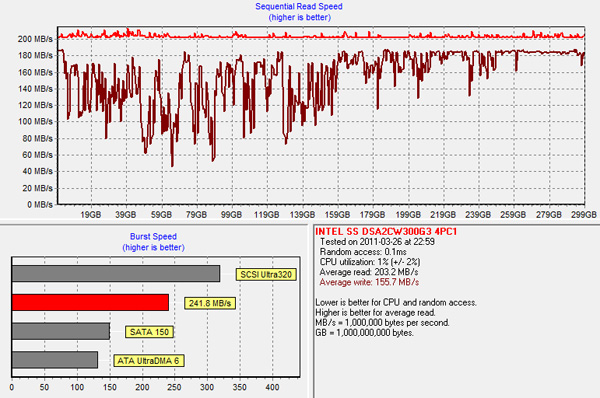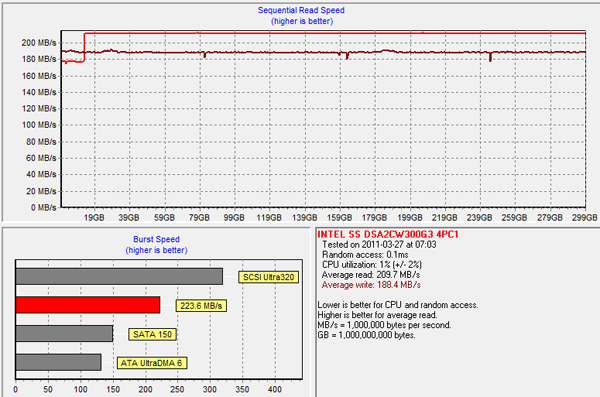The Intel SSD 320 Review: 25nm G3 is Finally Here
by Anand Lal Shimpi on March 28, 2011 11:08 AM EST- Posted in
- IT Computing
- Storage
- SSDs
- Intel
- Intel SSD 320
TRIM Performance
To test TRIM functionality we'll start off with a freshly secure erased Intel SSD 320:

Next we've filled up the 320 and tortured it with random writes for 20 minutes:

The 320 behaves a lot like the old X25-M G2 did when tortured. Minimum performance drops pretty low - Intel prefers cleaning up as late as possible to extend drive longevity. As a result, I wouldn't recommend using the 320 in an OS without TRIM support.
The format command in Windows 7 triggers TRIM across all of the drive's LBAs. The result is performance is nearly fully restored:











194 Comments
View All Comments
hackztor - Monday, March 28, 2011 - link
very sad from Intel. Was waiting for these and disappointed. Last gen performance...Price is not very exciting either.Wolfpup - Monday, March 28, 2011 - link
Looks good to me. Intel reliability, FINALLY larger drive sizes + automatic full disk encryption is awesome.Only bad thing is I can't actually find them on Amazon or Newegg yet, and I'd like one for a new system...
vol7ron - Monday, March 28, 2011 - link
You must be blind.This is to the X25-M G2 what Vista was to XP. It's a, "don't buy unless you have to" situation.
OCZ/SandForce have to be laughing - Intel is in shambles. First, SSD delays, then Mobo chipset recalls, then Chandra Anand quits, and now this crap.
Sure, their SSD is still reliable and it's not a bad product, but the pricing isn't even that great. Maybe they don't need to implement the SF-2k series algorithm, but some sort of compression engine would be nice. Claiming powerout reliability is like saying, "we just don't know how to make these capacitors hold a charge." Honestly, I don't care if you have to add a backup NiCad battery. Sure Intel has had reliability down, but they've had over a year to work on speed - this is akin to the Western Digital SSD release; of course it's much more attractive, but it's the reliability vs speed situation.
Who knows, maybe Intel's laughing at us just as hard as OCZ is laughing at them.
Griswold - Tuesday, March 29, 2011 - link
Actually, I'm laughing at you and your nonsense theories. Thanks for that.vol7ron - Tuesday, March 29, 2011 - link
:) a little lite accusations for a comical releaseThermogenic - Tuesday, March 29, 2011 - link
Intel is in shambles? LOL.vol7ron - Tuesday, March 29, 2011 - link
Okay, maybe a little bit of exaggeration, but this wasn't a strong release and they've had their large share of problems lately - don't you think?x86 will have a tough time dealing with RISC. I think RISC is just a better technology, since it doesn't have to deal with legacy instructions. That translates to performances and power efficiencies.
While Intel does still have some room to shrink the die, there isn't much room with current technologies. Also, the ARM chips will continue to decrease in die shrinks as well. That being said, there was some evidence that there could be a cheap alternative to Silicon on the horizon, which would allow for smaller theoretical components. (http://www.dailytech.com/Researchers+Claim+Molybde...
The way I see it, this is similar to when Intel moved the mem controller of the chipset and onto the die. They could have done it sooner, but they are good at extracting $$ from their customers. They reached the high clock rate track and had re-think their position.
While Intel may not be in shambles per se, in its current state, Intel has dished out a lot of debt, they haven't done too well with their NVidia relationship, and they're struggling in the mobile space. And I think AMD is still the better choice on the server front, if I recall correctly. This is all going on while their CEO is on the Obama's Job Council, which I still say that was probably not the best decision.
So, for a company that's been ahead for the last few years, they still have some short-term capabilities, but it's the long term that's important. They need to be successful in breaking into and building a new market segment (Mobile/HTPCs/SSDs).
Wiggy McShades - Tuesday, April 5, 2011 - link
Right now intel has to at very least TRY to hold on to x86 because they only have one competitor in this area, a competitor is severely limited compared to intel, which means huge profits. Intel could easily license the arm architecture and produce an soc that'd blow the everything out of the water. The reason I'm saying this is their manufacturing capabilities are the best in the world which means a LOT for producing microprocessors and currently their cpu's are just a RISC design that translates x86 instructions, so they'd really not even have to hire new engineers. Although then that means a loss in confidence in x86 and could lead to a transition to the arm architecture which they don't control. They probably know x86 isn't going to make it forever, but holding on to it for now is extremely profitable. We'll see how crafty they can get in shoehorning x86 into the mobile arena and that should truly decide how much longer x86 will be around. Intel can easily stand on their manufacturing capabilities and the insanely talented engineers they employ to compete in any up and coming markets, but it's just in their best interest to try and keep x86 dominance for now.FunBunny2 - Saturday, January 14, 2012 - link
Just re-reading, and Intel hasn't built a X86 chip with the instruction set in hardware in more than a decade. There chips are RISC with a X86 suit.piroroadkill - Friday, July 5, 2013 - link
Haha, it's fun reading these old comments, this is one so ill-conceived it makes me laugh.I have an Intel 320 120GB and it still works perfectly. Same can't be said for the OCZ Vertex 2 it replaced, and of course, we all know what happened to OCZ and partly Sandforce's reputation..